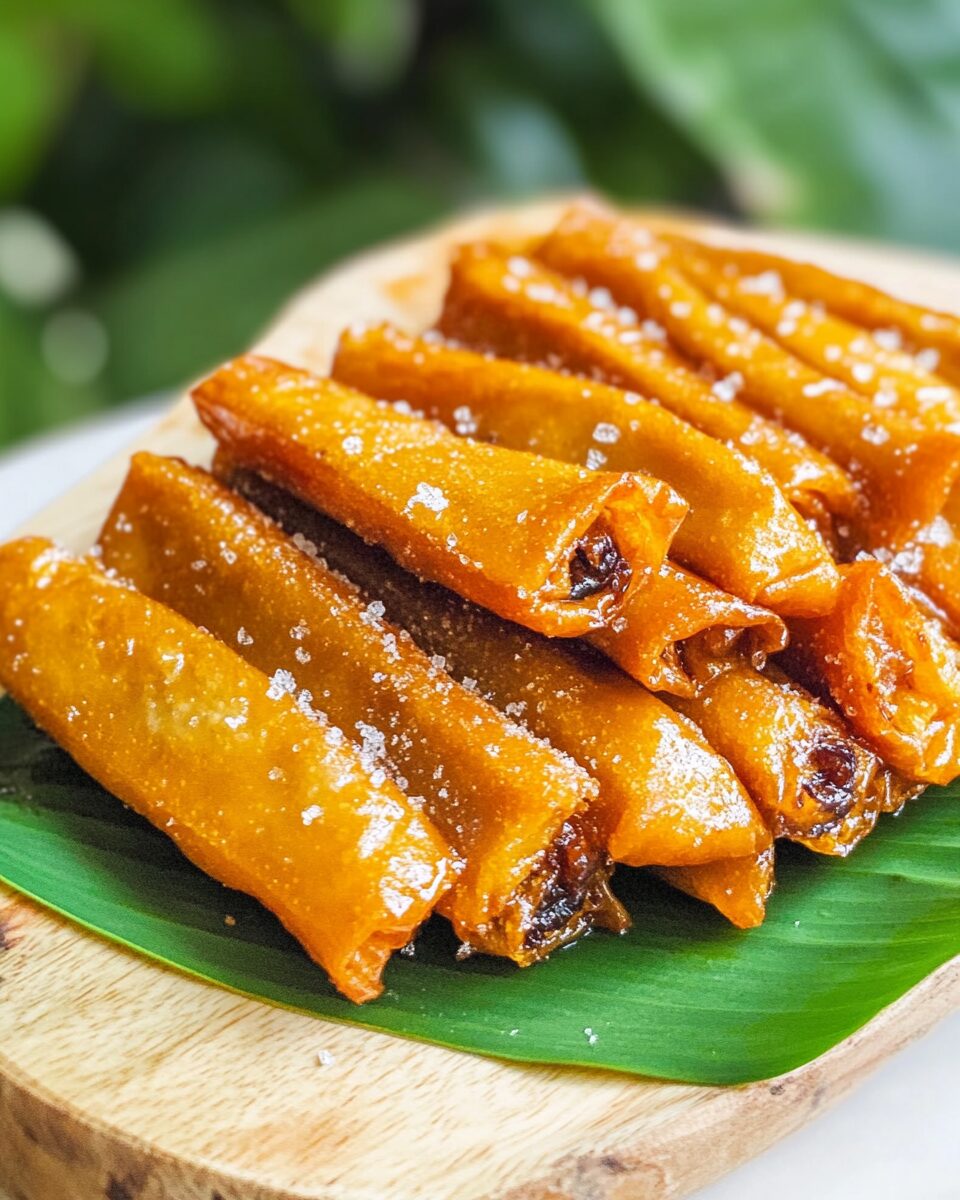Kamote Turon is a sweet Filipino snack made from thinly sliced sweet potatoes (kamote) wrapped in spring roll wrappers, then fried until golden brown and crisp. It’s a deliciously simple treat, often glazed with caramelized sugar, making it perfect for merienda or dessert.
FULL RECIPE
Ingredients
- 2 medium sweet potatoes (kamote), peeled and thinly sliced
- 1/2 cup brown sugar
- 12 spring roll wrappers
- 1/4 cup water (for sealing wrappers)
- Cooking oil (for deep frying)
Directions
- Peel and slice the sweet potatoes into thin strips or wedges.
- Roll each slice in brown sugar until fully coated.
- Place a sugared kamote slice diagonally on a spring roll wrapper.
- Fold the bottom corner over the filling, then fold in the sides and roll tightly.
- Seal the edge with a bit of water.
- Repeat with remaining kamote slices and wrappers.
- Heat oil in a deep pan over medium heat.
- Fry the turon in batches until golden brown and crispy.
- Drain on paper towels to remove excess oil.
- Optionally, sprinkle with extra sugar while hot or make a simple sugar glaze.
Nutritional Information
- Calories: 120
- Carbohydrates: 24g
- Protein: 1g
- Fat: 3g
- Fiber: 2g
- Sugar: 10g
- Sodium: 50mg
History and Origins of Kamote Turon
Kamote Turon, also known as sweet potato spring rolls, is a beloved Filipino snack with a rich cultural history. The snack traces its roots to the traditional Filipino practice of combining local ingredients with simple cooking methods. The use of sweet potatoes, or “kamote,” is an homage to the abundance of this crop in the Philippines. The dish has evolved over the years, with some variations incorporating additional fillings such as jackfruit or banana, but the classic version remains a favorite.
Why Kamote Turon is Popular in the Philippines
The popularity of Kamote Turon lies in its simplicity, affordability, and versatility. It is often enjoyed as an afternoon snack, paired with a refreshing drink during the hot months. Its easy preparation makes it a favorite for street vendors who sell the treat to passersby. The combination of crunchy spring roll wrappers with sweet, tender sweet potatoes creates a satisfying texture and flavor, appealing to people of all ages.
The Sweet Potato’s Role in Filipino Cuisine
Sweet potatoes, or “kamote,” are a staple in Filipino households. Known for their versatility, they can be boiled, fried, or mashed in various dishes. They are not only nutritious but also a popular ingredient in Filipino desserts. Kamote Turon uses the natural sweetness of the sweet potato, complemented by the caramelized sugar that coats it during frying. This makes it a perfect example of how the Filipino culinary tradition maximizes the use of local ingredients.
Health Benefits of Sweet Potatoes
Sweet potatoes are a rich source of vitamins, minerals, and fiber. They are high in vitamin A, which supports eye health and immune function. Additionally, they contain antioxidants that help reduce inflammation and combat oxidative stress in the body. Kamote Turon offers a delicious way to enjoy the health benefits of sweet potatoes while indulging in a sweet treat.
Variations of Kamote Turon
While the classic Kamote Turon is made with sweet potatoes and sugar, many variations exist. Some versions incorporate ripe bananas, jackfruit, or even a mixture of both. Others add a touch of cinnamon or vanilla to the sugar coating for an extra layer of flavor. These variations reflect the adaptability of the recipe and its ability to cater to different tastes and preferences.
Cooking Methods for Kamote Turon
Kamote Turon is traditionally deep-fried, but it can also be baked for a healthier alternative. Baking results in a less greasy snack, though it may not achieve the same level of crispiness as deep frying. In both cases, the key is to ensure that the spring roll wrappers are sealed properly to prevent the filling from spilling out during cooking.
Tips for Making Perfect Kamote Turon
To achieve the perfect Kamote Turon, it is essential to slice the sweet potatoes evenly so that they cook at the same rate. The spring roll wrappers should be tightly rolled to prevent them from unraveling while frying. For added crunch, make sure the oil is hot enough before frying. This will give the turon a golden-brown color and crisp texture without being too greasy.
Pairing Kamote Turon with Drinks
Kamote Turon pairs wonderfully with a variety of beverages. Traditionally, it is enjoyed with a cold glass of sago’t gulaman, a sweet drink made with tapioca pearls and agar jelly. However, it can also be served with tea, coffee, or a fresh fruit shake. The sweetness of the turon complements the refreshing nature of these drinks, making it an ideal snack for any time of the day.
Kamote Turon as a Street Food
In the Philippines, Kamote Turon is often sold by street vendors who fry the rolls on the spot, offering them fresh and hot. The sight and smell of golden brown turon cooking in the streets is enough to entice anyone to stop and purchase a piece. This snack is a testament to the Filipino love for street food, where quick and affordable treats are enjoyed by people from all walks of life.
The Cost-Effectiveness of Kamote Turon
One of the reasons Kamote Turon is so popular is its cost-effectiveness. Sweet potatoes are relatively inexpensive, especially in regions where they are grown locally. The ingredients for the spring roll wrappers and sugar are also affordable, making it an accessible treat for everyone. This affordability contributes to its widespread popularity across the Philippines, from rural areas to urban centers.
Kamote Turon as a Party Snack
Kamote Turon is not only a street snack but also a great addition to any party or celebration. Its sweet, crispy nature makes it an excellent finger food for gatherings, whether it’s a birthday, a family reunion, or a festive occasion. With its simple ingredients and ease of preparation, Kamote Turon can be made in large batches to serve guests.
Sweet Potato Variants Used in Kamote Turon
Different types of sweet potatoes can be used in Kamote Turon, each bringing its unique flavor and texture to the dish. Some sweet potatoes have a creamier texture, while others are firmer and hold up better during frying. The most commonly used variety is the purple-skinned, orange-fleshed sweet potato, which gives Kamote Turon a rich color and natural sweetness.
Kamote Turon and Filipino Family Traditions
Kamote Turon often holds sentimental value for many Filipinos, as it is a snack that brings back memories of family gatherings and childhood. In many Filipino homes, the preparation of Kamote Turon is a communal activity, with family members coming together to slice the sweet potatoes, wrap the rolls, and fry them. This shared experience adds a layer of warmth and tradition to the dish.
Kamote Turon in Modern Times
Though Kamote Turon has been around for generations, it has evolved with the times. Today, you may find it with modern twists, such as incorporating chocolate chips, coconut, or even Nutella in the filling. These contemporary versions cater to younger generations who are more adventurous with their tastes but still honor the original dish’s spirit.
Kamote Turon for Special Diets
For those on special diets, Kamote Turon can be adapted to suit various dietary restrictions. Vegan versions can be made by using plant-based wrappers and avoiding any dairy-based ingredients in the caramelization process. Gluten-free alternatives are also available by using gluten-free spring roll wrappers. This flexibility ensures that everyone can enjoy this delicious Filipino treat.
How to Store Kamote Turon
If you have leftover Kamote Turon, storing it properly will help maintain its freshness. It’s best to store the rolls in an airtight container to keep them from becoming soggy. If you want to preserve their crispiness, you can reheat them in an oven or toaster oven to regain some of the crunch before serving. Although fresh Kamote Turon is ideal, it can be kept for a day or two if stored correctly.
Kamote Turon’s Versatility for Different Occasions
Kamote Turon is incredibly versatile, making it suitable for various occasions. Whether you’re hosting a casual family dinner or preparing a dish for a potluck, it fits any setting. Its simplicity makes it easy to scale up for large gatherings, and its portability makes it a convenient snack for outdoor events.
The Cultural Significance of Kamote Turon
Kamote Turon is more than just a delicious snack; it holds cultural significance in the Philippines. It reflects the Filipino resourcefulness and ability to create something extraordinary from simple, locally available ingredients. The dish is a symbol of Filipino ingenuity, combining flavors and textures that appeal to both the humble and the sophisticated palate.
Why Kamote Turon is an Ideal Snack
The balance of sweet and savory in Kamote Turon makes it an ideal snack for any time of the day. The warm, crispy exterior contrasts perfectly with the soft and sweet filling inside, creating a satisfying eating experience. Whether you’re craving something sweet or just need a quick energy boost, Kamote Turon fits the bill.
The Future of Kamote Turon
As Filipino cuisine continues to gain global recognition, dishes like Kamote Turon are starting to make their way into international markets. This sweet snack has the potential to become a popular treat outside the Philippines, with its simple ingredients and delicious taste appealing to people worldwide. As food enthusiasts continue to experiment with new flavors, Kamote Turon may evolve further, but its roots in Filipino culture will remain strong.
Conclusion
Kamote Turon is a delicious and versatile snack that embodies the heart of Filipino cuisine. Its history, cultural significance, and wide appeal make it a dish worth celebrating. Whether enjoyed as a simple street food or elevated for special occasions, Kamote Turon is a testament to the Filipino spirit of innovation and community. With its perfect balance of sweet and savory flavors, this treat is sure to remain a beloved part of Filipino culinary traditions for generations to come.






